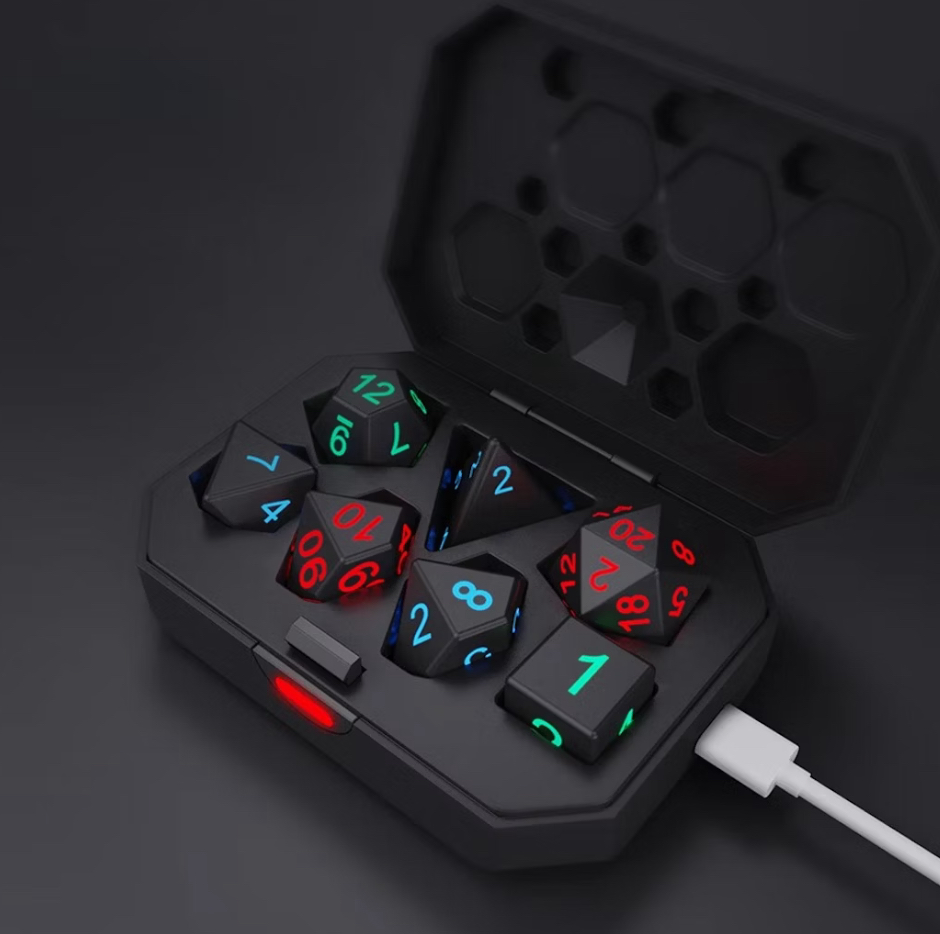Dice have existed for millennia. From ancient Mesopotamian cubes carved from bone to the plastic polyhedrons of modern tabletop gaming, the dice has always served one purpose: to bring chance into human hands. But today, it’s not just about randomness or probability—it’s also about aesthetic. Enter the LED luminous die: a marriage of tradition and technology, randomness and spectacle.
More Than a Gimmick
At first glance, LED dice might seem like a novelty—another flashy gadget riding the wave of RGB obsession. But look closer. These glowing cubes are more than gimmicks. They’re part of a larger movement in gaming and design: the push to turn even the smallest components into immersive experiences. Players don’t just want to play; they want to feel the game.
With the rise of high-production tabletop experiences—games like Gloomhaven, Dungeons & Dragons, and Cyberpunk RED—the bar for immersion is high. Soundtracks, custom miniatures, interactive maps, and now, LED dice, all serve one purpose: to break the boundary between the player and the world they inhabit. When a die pulses red as it lands a critical hit or glows ominous blue in a magic-heavy scene, it reinforces the narrative. It gives weight to randomness.
How They Work
Technically, the concept is simple: a die embedded with LED lights, motion sensors, and a tiny battery. Most use accelerometers to detect movement and trigger lighting effects upon a roll. Some are pressure-activated or even app-connected, syncing with virtual platforms via Bluetooth. Others are programmable, letting users assign specific colors to certain numbers or events.
The design challenges, however, are non-trivial. The dice must be:
- Balanced: Even weight distribution is critical to fairness.
- Durable: The electronics must survive hundreds—if not thousands—of impacts.
- Compact: The components need to fit inside a small cube without breaking the surface symmetry.
- Rechargeable or efficient: Many models offer wireless charging or low-energy lighting to extend battery life.
This combination of precision engineering and minimalist design puts LED dice in the same league as smartwatches—tiny tech with massive potential.
The Aesthetic Upgrade
There’s no denying the visual appeal. LED dice aren’t just functional; they’re beautiful. A translucent D20 glowing like a crystal orb in a darkened room turns an ordinary gaming session into something cinematic. Some variants offer slow color fades, reactive flashes, or thematic color palettes—blood red for vampires, neon green for sci-fi, silver-blue for winter-themed campaigns.
In a world saturated with screens, the tactile, glowing die offers something different: a physical artifact with digital charm. It’s analog intimacy, augmented by light.
Market Explosion
Until a few years ago, LED dice were the stuff of Kickstarter projects and niche forums. But demand has spiked. Companies like Pixels, Halfsies, and Wizard Dice are now shipping out units faster than ever. There’s even a growing secondary market for custom mods, 3D-printed dice shells, and specialty LED effects.
Prices vary. Entry-level models can cost $20–$30, while high-end programmable or artisan models can fetch upwards of $100 per die. For serious gamers, it’s not just a tool—it’s a statement piece.
Where Tech Meets Roleplay
The impact of LED dice isn’t limited to aesthetics. They’re reshaping how players engage with games. A light-up roll grabs attention. It adds drama. It makes moments feel earned.
In live-streamed games (like those seen in Critical Role or Dimension 20), the visual flair enhances the viewer experience. The dice become performative, not just mechanical. Streamers often pair these dice with custom sound cues or camera effects, turning each roll into a mini-event.
And for neurodivergent players, the sensory feedback—light, motion, sometimes even vibration—can enhance focus and enjoyment, adding a layer of engagement that standard dice don’t offer.
Criticism and Concerns
Of course, not everyone is glowing with praise. Purists argue that the electronics could affect balance. Even slight internal asymmetries could skew roll outcomes—an issue particularly relevant in competitive play. Some gaming tournaments outright ban LED dice for this reason.
Then there’s the sustainability issue. Lithium batteries, e-waste, and plastic materials raise valid environmental questions. Are we trading long-term sustainability for short-term spectacle?
And finally, there’s cost and accessibility. While cool, LED dice are luxury items. Not every player can or wants to spend $100 on a single die, especially when standard sets are available for a fraction of the price.
The Future of Dice
Still, the trend is clear: dice are evolving. As augmented reality, AI-driven gaming systems, and app-integrated mechanics continue to grow, LED dice may become more than just flashy accessories. Imagine dice that track roll history, connect with dungeon master dashboards, or even simulate magical effects when paired with AR glasses.
We’re not far from a world where the humble die is no longer just a cube of chance—but a data point in a living, breathing narrative system.
Flow
LED luminous dice represent more than technological novelty. They’re symbols of where gaming is headed—toward immersion, personalization, and sensory engagement. They light up not just because they can, but because players want something more. More drama. More connection. More story.
In a culture where analog and digital increasingly blur, these dice stand at the crossroads. Glowing, waiting, and ready to roll.
No comments yet.








